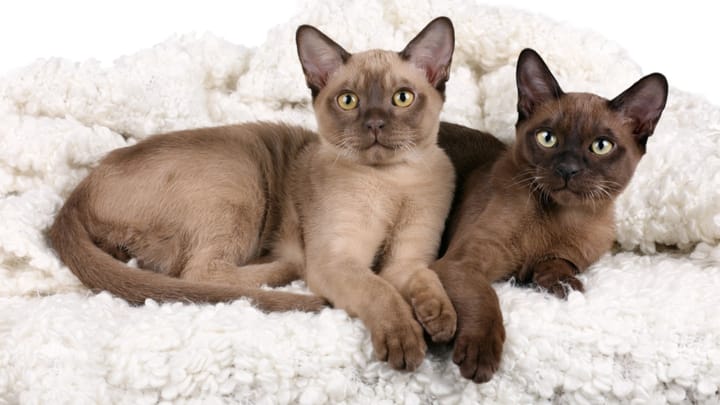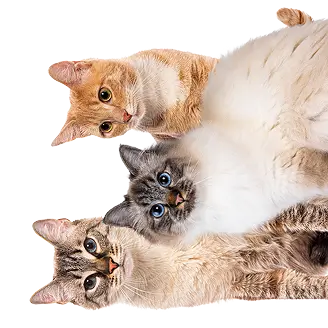Burmese
Other name: Malayan


Despite the similar name, this breed bears no resemblance to the Birman (also known as the “Sacred Cat of Burma”). It is also called the Malayan, particularly in the United States. All Burmese have the same ancestor, a brown-coated cat, whose coat was darker on its extremities, which was brought back from Burma. So now you see where the name comes from! Note that there are two lineages of Burmese: one of English origin and the other American. It is only by a few facial morphological differences that we can distinguish between them.
|
Life expectancy |
The Burmese has a life expectancy of between 13 and 15 years |
|
Temperament |
|
|
Adult size |
Female
Between 10 and 11 in
Male
Between 11 and 12 in
|
|
Adult weight |
Female
Between 7 and 11 lb
Male
Between 9 and 13 lb
|
|
Coat colour
For the English Burmese, base colours of sable, blue, chocolate and champagne have been recognised since the origin of the breed. New colours have been added to the breed standard over the years, such as red, cream and tortoiseshell. The American Burmese differs slightly from the English variety: while red, cream and tortoiseshell colours are associated with the Malayan breed, the colours sable, blue, chocolate and lilac are also recognised as part of the breed standard for the American variety. |
Brown Red Cream Blue |
|
Type of coat
Short |
Short Long |
|
Eye colour
Golden yellow to meet the breed standard. However, some cats of this breed have golden or coppery eyes. |
Yellow
Blue
|
|
Purchase price |
The Burmese costs between £400 and £700 |
Burmese kittens are born with grey/blue eyes and a light coat, but as they grow, the eye colour will change to yellow and the coat will darken on the coldest parts of the body.
More details about the Burmese
Burmese: Origins and history
From as early as 1350, a collection called "book of cat poems" which extended over the following four centuries already described a cat resembling this breed. But the certainty of this breed’s birth rests on their ancestor, a Tonkinoise cat called Wong-Mau that a man by the name of Thompson brought back from Burma one day. She was mated with a seal or chocolate point siamese. One of the kittens in the litter was then crossed with Wong-Mau in order to obtain this all-over brown colour with yellow eyes. This is how the first Burmese kittens were born, along with the breeding programme for the breed. It took six years for this breed to be recognised by the Cat Fanciers’ Association (CFA) in its sable colour variety.
In Europe, the first cats of this breed appeared in Britain in 1947. These first Burmese were crossed with typically oriental Siameses, which allowed the development of a more triangular head than their American counterparts. It is also through this breeding programme that other colors (red, cream tortoiseshell) were recognised in Europe over the years.
Physical characteristics of the Burmese
The American version has a round-shaped head and the structure of its body makes them weightier cats than their slimmer English triangular-headed counterpart. All other body features are identical.
The musculature of these cats is well developed and toned, which makes them very agile at moving their medium-sized yet heavy body. These little athletes always have their eyes on you: they are large and round, and shine a deep gold. Their silky fur lies flat against their body and is reputed to be one of the nicest to touch out of all the house cats.
Burmese: Characteristics
Burmese: Behaviour
Breed compatibility Burmese
Burmese: Purchase price
The purchase price of this cat can vary from £400 to £700 depending on its origin (breeder), pedigree, age, etc. Then for the maintenance budget, it takes about £25 per month to offer this breed a good quality of food and litter.
Burmese: Shedding
Light
Their spring moult is very light, so brushing will not need to be more any more frequent at this time of the year.
Burmese: Grooming
Given their fur is short with very little undercoat, a weekly brush will be enough.
Burmese: Health
The life expectancy of the Burmese is around 14 years.
Being without an undercoat, the Malayan’s magnificent, shiny fur that sits close to its skin will not adequately protect it from the cold.
The Malayan’s strong, solid body tends to give them a large appetite, especially if they are a particularly energetic and active individual. It is therefore important to make sure that this appetite of theirs does not turn into greed!
This cat is susceptible to develop the same illnesses as any other non-pedigree cat, as well as those listed below:
Craniofacial abnormality of the American Burmese (it is possible to test for this using genetic screening)
Hypokalemic myopathy causing weakness as well as muscle pain (can also be screened)
Gangliosidosis GM2 where the cat presents with a deficit of a particular enzyme that causes brain damage (can also be screened)
Hypertrophic cardiomyopathy, the annual screening for which is carried out by ultrasound examination using a doppler.
Burmese are also reportedly more at risk of developing vitiligo, a skin condition that causes the loss of natural hair pigmentation.
Puberty occurs around the age of 9 months in the Burmese cat. An average litter may contain 6 kittens, meaning its prolificacy is slightly higher than the average of other cat breeds.





